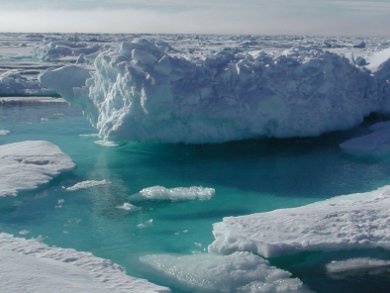Freshwater in the Arctic Ocean lies as a light layer on top of the deeper salty and warm ocean layers and extensively cuts off heat flow to the ice and atmosphere. Changes in this layer are major control parameters for the sensitive heat balance of the Arctic. The amount of freshwater flowing out of the Arctic influences the formation of deep water in the Greenland and Labrador Sea and thus has impacts on global ocean circulation.
Dr. Benjamin Rabe, Alfred Wegener Institute for Polar and Marine Research in the Helmholtz Association, and colleagues found through unprecedented summer-season sampling of the Arctic Ocean during the period 2006 to 2008 and comparison to observations from 1992 to 1999, that the freshwater content of the upper Arctic Ocean has increased by about 20 % (8,400 ± 2,000 km3) since the 1990s. This is close to the annual export of freshwater (liquid and solid) from the Arctic Ocean reported in the literature.
The considerable changes in the upper water layers primarily comprise a decline in salt concentration. Another, though minor, effect is that the low-salt layers are thicker than before. The freshwater content of the Arctic Ocean may rise due to increased sea ice or glacier melt, precipitation, river inputs, or less export of freshwater from the Arctic (liquid and solid).
Dr. Michael Karcher, Alfred Wegener Institute, simulated the observed processes using the NAOSIM coupled ocean/sea ice model. Measurements and the model show that the changes in the Arctic freshwater content encompass far larger areas than assumed to date.
Photo: (C) Alfred-Wegener-Institut
- An assessment of Arctic Ocean freshwater content changes from the 1990s to the 2006-2008 period,
Benjamin Rabe, Michael Karcher, Ursula Schauer, John M. Toole, Richard A. Krishfield, Sergey Pisarev, Frank Kauker, Rüdiger Gerdes, Takashi Kikuchi,
J. Deep-Sea Res. 2011, I 58, 173–185.
DOI: 10.1016/j.dsr.2010.12.002




